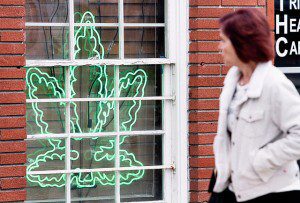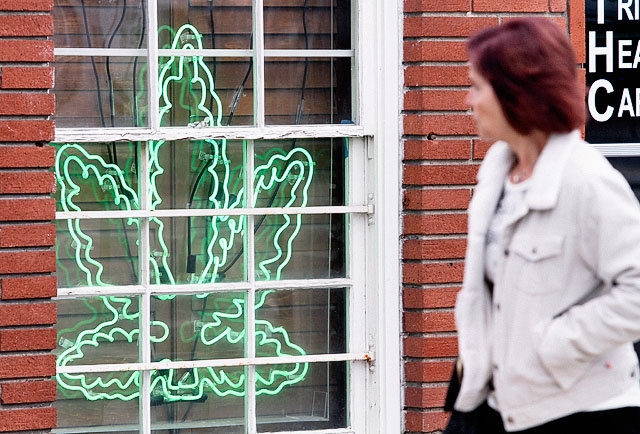
A pedestrian walks past a marijuana leaf neon sign advertising a medical marijuana provider along a street in the Sherman Oaks section of Los Angeles, Calif., in this photo from Jan. 26, 2010. States may be saying yes to medical marijuana, but local governments are increasingly using their laws to keep dispensaries out. (AP file photo)
WESTFIELD – The Board of Health discussed implementation of the medical marijuana program approved by the state following the passage of a referendum question by voters in November.
That law requires the state Department of Public Health to promulgate regulation by July 1, 1013 to establish the administrative framework. The law initially would allow up to 35 dispensaries across the state, but no more than five per county, although there is a provision in the law to allow that number to increase.
Health Director Michael Suckau said the DPH will create regulations to provide guidelines for growers, dispensaries and patients, who will be required to have special identification for the medical marijuana.
“So until then, we’re waiting,” Suckau said. “Several communities, Melrose, Wakefield and Reading have already adopted local prohibitions against dispensaries.”
Westfield is also assessing what zoning regulations would be needed to regulate the program locally. That issue is currently before the City Council and the Planning Board.
Suckau said the Planning Board is conducting a public meeting on Tuesday Feb. 5, 2013 and has invited Health Board members to participate in that discussion. The Planning Board will make a recommendation to the City Council to adopt ordinances to restrict the dispensaries, and perhaps cultivation sites, to certain zoning districts within the city.
Suckau said that the board may have “some piece” of the medical marijuana program, but that the DPH will collect the fees and oversee the implementation and enforcement of regulations.
Commissioner John Lehman, a pharmacist, said that the state has very rigid restrictions and controls on the dispensing of narcotics through pharmacies to patients to prevent abuse.
“Who is going to oversee the marijuana dispensing process?” he asked.
Lehman raised that question following a discussion of whether physicians will write a prescription for the drug or merely document that the patient has a medical condition which is qualified under the medical marijuana guidelines.
“Everything is a gray area, we need to have rules we have to follow,” he said. “Will the dispensaries need to have a licensed pharmacist? Patients are entitled to a 60-day supply of marijuana, but how much is that? Is that a bag this big?” he said holding his hands apart, “or a bag this big?” as he spread his hands further apart. That has to be defined.
Lehman said that another concern with dispensing any drug is the physical reaction of that drug on the patients ability to operate machinery and vehicles. Drugs that could impair normal functions are required to have warning labels.
Dr. Stan Strzempko said that the DPH “does oversight well” and that the regulations created should address those issued and provide guidelines for local Boards of Health that act as the DPH’s local agents under state law.


